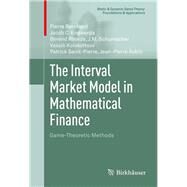The Interval Market Model in Mathematical Finance
, by Bernhard, Pierre; Engwerda, Jacob C.; Roorda, Berend; Schumacher, J. M.; Kolokoltsov, Vassili- ISBN: 9780817683870 | 0817683879
- Cover: Hardcover
- Copyright: 12/14/2012
Toward the late 1990s, several research groups independently began developing new, related theories in mathematical finance. These theories did away with the standard stochastic geometric diffusion Samuelson market model (also known as the Black-Scholes model because it is used in that most famous theory), instead opting for models that allowed minimax approaches to complement or replace stochastic methods. Among the most fruitful models were those utilizing game-theoretic tools and the so-called interval market model. Over time, these models have slowly but steadily gained influence in the financial community, providing a useful alternative to classical methods.A self-contained monograph, The Interval Market Model in Mathematical Finance: Game-Theoretic Methods assembles some of the most important results, old and new, in this area of research. Written by seven of the most prominent pioneers of the interval market model and game-theoretic finance, the work provides a detailed account of several closely related modeling techniques for an array of problems in mathematical economics. The book is divided into five parts, which successively address topics including:· probability-free Black-Scholes theory;· fair-price interval of an option;· representation formulas and fast algorithms for option pricing;· rainbow options;· tychastic approach of mathematical finance based upon viability theory.This book provides a welcome addition to the literature, complementing myriad titles on the market that take a classical approach to mathematical finance. It is a worthwhile resource for researchers in applied mathematics and quantitative finance, and has also been written in a manner accessible to financially-inclined readers with a limited technical background.






